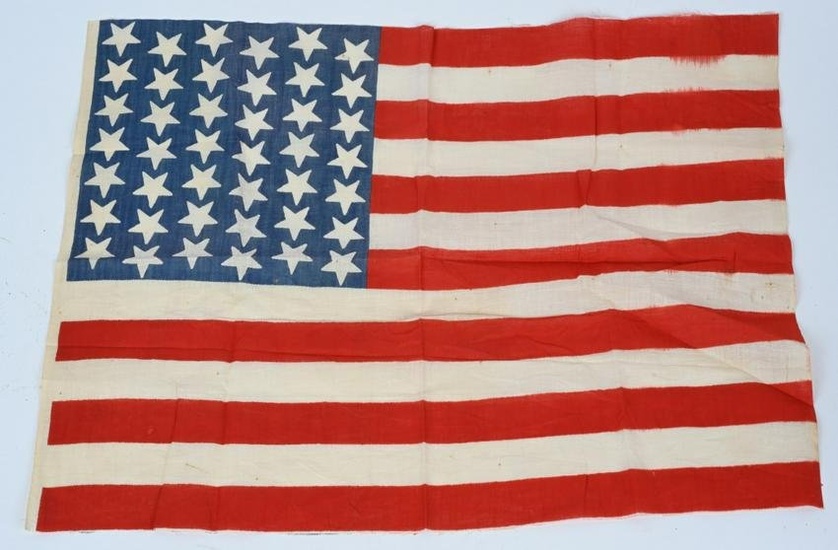RARE SHORT LIVED 42 STAR AMERICAN FLAG CIRCA 1890
Beginning with the Third Flag Act of 1818, the tradition of adding a star for each new state added to the Union became the customary way of updating the American Flag. Under unusual circumstances, some star counts on American flags are considered "Unofficial". This is a result of the guidelines specified by the Third Flag Act for adding new stars to the flag. The act of 1818 decreed that upon "the admission of every new state into the Union, one star be added to the union of the flag; and that such addition shall take effect of the fourth day of July then next succeeding such admission." On a few rare occasions, however, more than one state was added to the Union within the same year, prior to the 4th of July. Such was the case when Washington State entered the Union on November 11, 1889. At the time, 38 stars was still the official star count on the American Flag. North Dakota and South Dakota entered the Union on November 2, 1889, bringing the count from 38 to 40. Just 6 days later, on November 8, 1889, Montana became the 41st state, and then, just 3 days later, on November 11, 1889, Washington State became number 42. For 243 days, the United States had 42 states, but just one day before Washington State's 42 would have become official, on July 3, 1890, Idaho entered the Union as the 43rd state. Consequently, the 42 star flag representing Washington Statehood never became official, despite having a period of 243 days with 42 states. Flag manufacturers often disregarded the "official" star count, and produced flags and sold flags that were current regardless of the official national star count. This beautiful flag of 42 stars is an example of an "unofficial" star count. The canton of the flag is clamp-dyed. In the process of clamp dying, first patented in the 1850s, two plates with the pattern to be dyed were produced on two matching metal plates which were clamped together. The fabric was them immersed in a vat of the desired colored dye, and the areas that were unclamped retained the dye. When the immersed material dried, the clamps and plates would be removed, leaving the areas untouched by the dye in its original state. This flag is a fabulous flag of a large 42 star clamp-dyed cotton flag, circa 1890. Its "dancing" stars measuring 18 X 24 inches.
[ translate ]View it on
Sale price
Estimate
Reserve
Time, Location
Auction House
Beginning with the Third Flag Act of 1818, the tradition of adding a star for each new state added to the Union became the customary way of updating the American Flag. Under unusual circumstances, some star counts on American flags are considered "Unofficial". This is a result of the guidelines specified by the Third Flag Act for adding new stars to the flag. The act of 1818 decreed that upon "the admission of every new state into the Union, one star be added to the union of the flag; and that such addition shall take effect of the fourth day of July then next succeeding such admission." On a few rare occasions, however, more than one state was added to the Union within the same year, prior to the 4th of July. Such was the case when Washington State entered the Union on November 11, 1889. At the time, 38 stars was still the official star count on the American Flag. North Dakota and South Dakota entered the Union on November 2, 1889, bringing the count from 38 to 40. Just 6 days later, on November 8, 1889, Montana became the 41st state, and then, just 3 days later, on November 11, 1889, Washington State became number 42. For 243 days, the United States had 42 states, but just one day before Washington State's 42 would have become official, on July 3, 1890, Idaho entered the Union as the 43rd state. Consequently, the 42 star flag representing Washington Statehood never became official, despite having a period of 243 days with 42 states. Flag manufacturers often disregarded the "official" star count, and produced flags and sold flags that were current regardless of the official national star count. This beautiful flag of 42 stars is an example of an "unofficial" star count. The canton of the flag is clamp-dyed. In the process of clamp dying, first patented in the 1850s, two plates with the pattern to be dyed were produced on two matching metal plates which were clamped together. The fabric was them immersed in a vat of the desired colored dye, and the areas that were unclamped retained the dye. When the immersed material dried, the clamps and plates would be removed, leaving the areas untouched by the dye in its original state. This flag is a fabulous flag of a large 42 star clamp-dyed cotton flag, circa 1890. Its "dancing" stars measuring 18 X 24 inches.
[ translate ]


